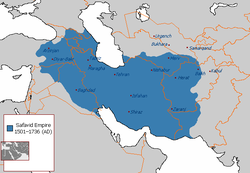
Back Safawi ACE Safawiden Afrikaans Safawiden ALS Dinastía Safavida AN السلالة الصفوية Arabic صفويين ARZ Səfəvi xanədanı Azerbaijani صفوی خاندانی AZB Сәфәүиҙәр Bashkir Сефевіды Byelorussian
 Der er for få eller ingen kildehenvisninger i Ismail I § Shāh Ismā'īl I og derefter, hvilket er et problem. Du kan hjælpe ved at angive troværdige kilder til de påstande, som fremføres.
Der er for få eller ingen kildehenvisninger i Ismail I § Shāh Ismā'īl I og derefter, hvilket er et problem. Du kan hjælpe ved at angive troværdige kilder til de påstande, som fremføres.
Safavideriget | |||||||||||||
|---|---|---|---|---|---|---|---|---|---|---|---|---|---|
| Imperium | |||||||||||||
| 1501–1736 | |||||||||||||
 Safavideriget | |||||||||||||
| Hovedstad | Tabriz (1501-1555) Qazvin (1555-1598) Isfahan (1598-1736) | ||||||||||||
| Sprog |
| ||||||||||||
| Religion | Shia-islam | ||||||||||||
| Regeringsform | Monarki | ||||||||||||
| Shāh | |||||||||||||
• 1501-1524 | Ismā'īl I | ||||||||||||
• 1524-1576 | Tahmāsp I | ||||||||||||
• 1576-1577 | Ismā'īl II | ||||||||||||
| Muhammed Khudābanda | |||||||||||||
• 1587-1629 | 'Abbās I | ||||||||||||
• 1732-1736 | 'Abbās III (sidste) | ||||||||||||
| Shāh (de facto) | |||||||||||||
| Mahmud Hotaki | |||||||||||||
• 1725-1729 | Ashraf Khan Hotaki | ||||||||||||
| Historie | |||||||||||||
• Grundlæggelse | 1501 | ||||||||||||
• Opløsning | 1736 | ||||||||||||
| |||||||||||||
Safavideriget (persisk: دولت صفوی eller دولت صفویه, tyrkisk: Safevî Devleti, aserbajdsjansk: Səfəvilər Dövləti, صفویلر, kurdisk: Dewleta Sefewî, georgisk: სეფიანთა დინასტია) var et shia-muslimsk dynasti af kurdisk oprindelse [11] der var et af de mest betydningsfulde dynastier i Iran. Det er også begyndelsen af moderne iransk historie.[12] Safavideriget blev et af de største iranske imperier siden den muslimske erobring af Persien[13][14][15][16]. Safaviderne regerede fra 1501 til 1722 og igen fra 1729 til 1736. Under dets største udbredelse kontrollerede det hele det moderne Iran, Aserbajdsjan og Armenien, det meste af Irak, Georgien, Afghanistan, og Kaukasus, dele af Pakistan, Tadjikistan, Turkmenistan, Tyrkiet, og Usbekistan.
Safaviderne var den direkte årsag til, at shia-islam i så høj grad er udbredt i store dele af Vestasien og Kaukasus. Det var én af grundene til at Safavideriget blev anset som en trussel af det sunnitiske Osmannerrige. Det har flere gange resulteret i krig mellem de to stater.
- ^ Roemer, H. R. (1986). "The Safavid Period". The Cambridge History of Iran, Vol. 6: The Timurid and Safavid Periods. Cambridge: Cambridge University Press, pp. 189–350. ISBN 0-521-20094-6, p. 331: "Depressing though the condition in the country may have been at the time of the fall of Safavids, they cannot be allowed to overshadow the achievements of the dynasty, which was in many respects to prove essential factors in the development of Persia in modern times. These include the maintenance of Persian as the official language and of the present-day boundaries of the country, adherence to the Twelever Shi'i, the monarchical system, the planning and architectural features of the urban centers, the centralised administration of the state, the alliance of the Shi'i Ulama with the merchant bazaars, and the symbiosis of the Persian-speaking population with important non-Persian, especially Turkish speaking minorities".
- ^ a b c Rudi Matthee, "Safavids" in Encyclopædia Iranica, accessed on April 4, 2010. "The Persian focus is also reflected in the fact that theological works also began to be composed in the Persian language and in that Persian verses replaced Arabic on the coins." "The political system that emerged under them had overlapping political and religious boundaries and a core language, Persian, which served as the literary tongue, and even began to replace Arabic as the vehicle for theological discourse".
- ^ Ronald W Ferrier, The Arts of Persia. Yale University Press. 1989, p. 9.
- ^ a b John R Perry, "Turkic-Iranian contacts", Encyclopædia Iranica, January 24, 2006: "...written Persian, the language of high literature and civil administration, remained virtually unaffected in status and content"
- ^ Fodnotefejl: Ugyldigt
<ref>-tag; ingen tekst er angivet for referencer med navnetCyril Glassé 2003, pg 392 - ^ Arnold J. Toynbee, A Study of History, V, pp. 514-15. excerpt: "in the heyday of the Mughal, Safawi, and Ottoman regimes New Persian was being patronized as the language of literae humaniores by the ruling element over the whole of this huge realm, while it was also being employed as the official language of administration in those two-thirds of its realm that lay within the Safawi and the Mughal frontiers"
- ^ a b Fodnotefejl: Ugyldigt
<ref>-tag; ingen tekst er angivet for referencer med navnetmazzaoui - ^ Ruda Jurdi Abisaab. "Iran and Pre-Independence Lebanon" in Houchang Esfandiar Chehabi, Distant Relations: Iran and Lebanon in the Last 500 Years, IB Tauris 2006, p. 76: "Although the Arabic language was still the medium for religious scholastic expression, it was precisely under the Safavids that hadith complications and doctrinal works of all sorts were being translated to Persian. The 'Amili (Lebanese scholars of Shi'i faith) operating through the Court-based religious posts, were forced to master the Persian language; their students translated their instructions into Persian. Persianization went hand in hand with the popularization of 'mainstream' Shi'i belief."
- ^ Fodnotefejl: Ugyldigt
<ref>-tag; ingen tekst er angivet for referencer med navnetsavory07 - ^ Fodnotefejl: Ugyldigt
<ref>-tag; ingen tekst er angivet for referencer med navnetcambridgesafa - ^ Empires: Safavid and Qajar | Encyclopedia.com
- ^ "SAFAVID DYNASTY". Encyclopædia Iranica.
- ^ Helen Chapin Metz. Iran, a Country study. 1989. University of Michigan, p. 313.
- ^ Emory C. Bogle. Islam: Origin and Belief. University of Texas Press. 1989, p. 145.
- ^ Stanford Jay Shaw. History of the Ottoman Empire. Cambridge University Press. 1977, p. 77.
- ^ Andrew J. Newman, Safavid Iran: Rebirth of a Persian Empire, IB Tauris (March 30, 2006).

